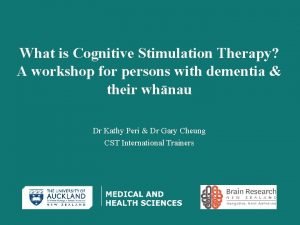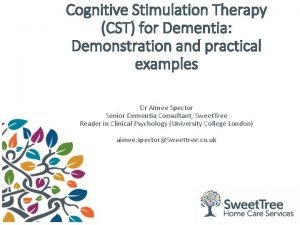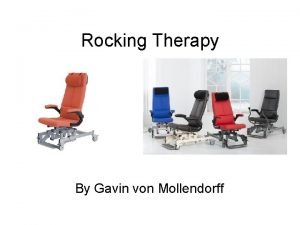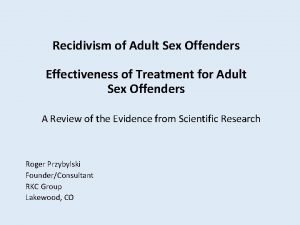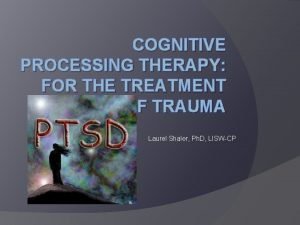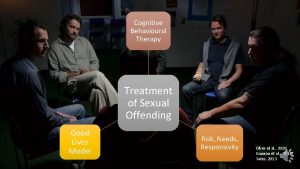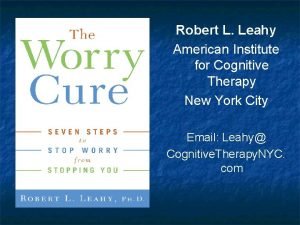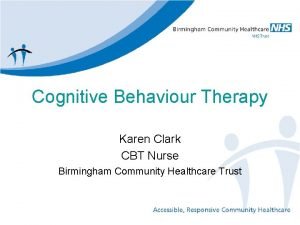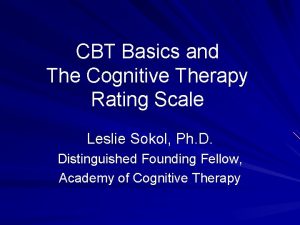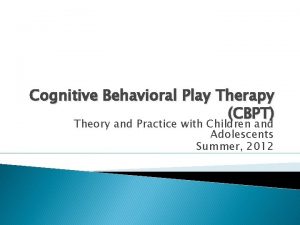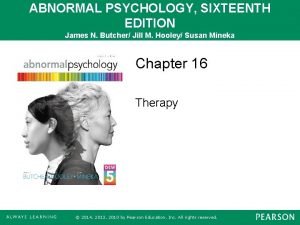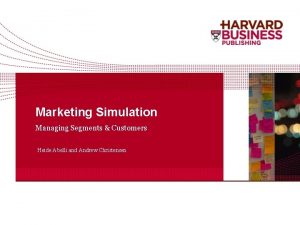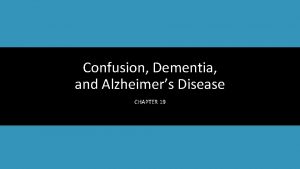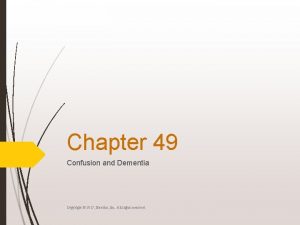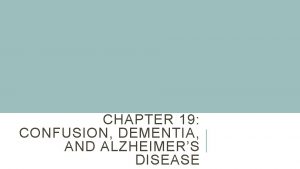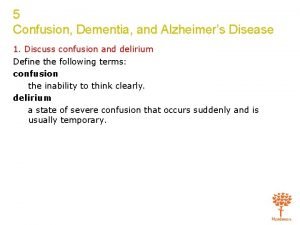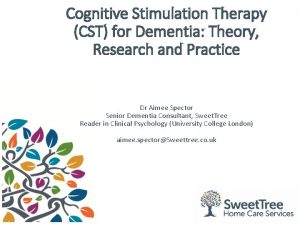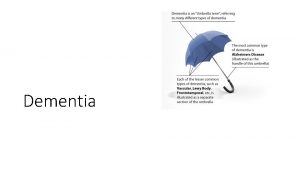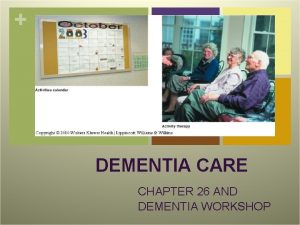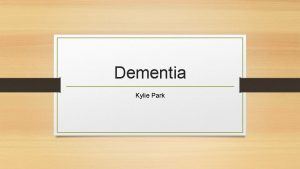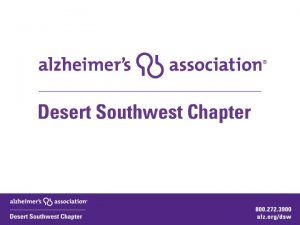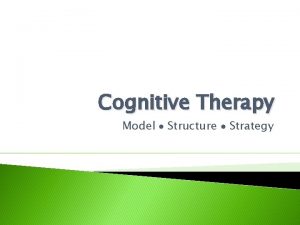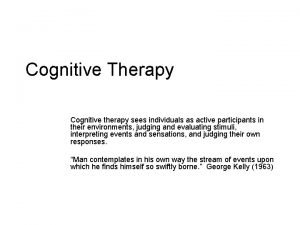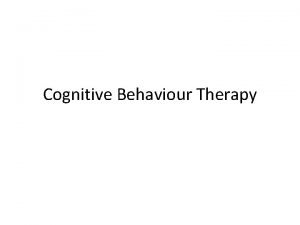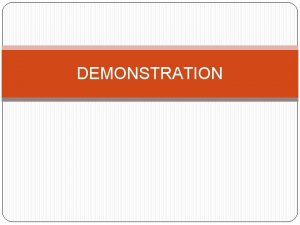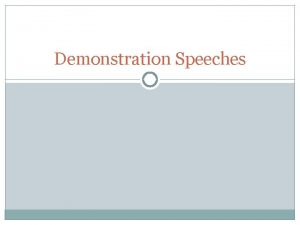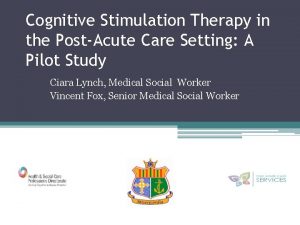Cognitive Stimulation Therapy CST for Dementia Demonstration and






















- Slides: 22

Cognitive Stimulation Therapy (CST) for Dementia: Demonstration and practical examples Dr Aimee Spector Senior Dementia Consultant, Sweet. Tree Reader in Clinical Psychology (University College London) aimee. spector@Sweettree. co. uk

What is CST? • A brief group programme, for people with mild to moderate dementia, living in a range of settings. • 14 themed sessions, typically twice a week for 7 weeks. Includes word association / categorisation, current affairs, food, and number games. • Key aims: to improve cognitive functioning using techniques that exercise different cognitive skills. • Achieved through a variety of means including, executive functioning tasks (e. g. categorisation), multi-sensory stimulation, and reminiscence as an aid to orientation. • Based on concept of ‘use it or lose it’: brain needs to be exercised in order for skills to be retained. • Several clinical trials in the UK and worldwide have shown significant benefits in cognition, quality of life and activities of daily living following CST.

CST: The Sessions Physical games Being creative Sound Categorising objects Childhood Orientation Food Using money Current affairs Number games Faces / scenes Word games Associated words Team quiz

CST: Key Principles 1 Mental stimulation 2 New ideas, thought and associations 3 Using orientation, but sensitively and implicitly 4 Opinions, rather than facts 5 Using reminiscence, and as an aid to the here-and-now 6 Providing triggers to aid recall 7 Continuity and consistency between sessions 8 Implicit (rather than explicit) learning 9 Stimulating language 10 Stimulating executive functioning 11 Person-centred 12 Respect 13 Involvement 14 Inclusion 15 Choice 16 Fun 17 Maximising potential 18 Building / strengthening relationships

Mental stimulation • Getting people’s minds active and engaged. • You might explain that you are trying to get them to exercise skills that may not be used so much and stimulate different parts of the brain. Some sessions will be harder than others, but trying hard = good mental exercise! It can be useful to explain the evidence for CST from research. • When you plan sessions, the aim is to pitch activities so that people have to make an effort, but not too high (so they can potentially feel deskilled).

New thoughts, ideas and associations. • Often with people with dementia, we tend to talk about things from the past. Whilst this is enjoyable for people, it often involves recalling information which has been over-rehearsed. • The aim of CST is to continually encourage new ideas, thoughts and associations, rather than just recall previously learned information. • Example – faces session. Show more than one face and ask questions such as ‘what do they have in common? ’ ‘How are they different? ’ ‘Who would you rather be? ’


Opinions rather than facts • People will often be wrong. If we ask people for their opinions, then they may be amusing, sad, unusual, controversial or puzzling, but they cannot be wrong. • Example: ask “what do you think of politicians? ” rather than “who is prime minister? ” • Avoid questions beginning ‘Who can remember…? ’

Using reminiscence as an aid to the here-andnow • Using past memories is an excellent way of tapping into a strength that many people with dementia have, in terms of recalling experiences. • Ensure you know the background of the group members to avoid upsetting them when talking about past memories. • Reminiscence can also be a useful tool towards orientation, a key goal of CST. E. g. comparing prices over time in ‘Using Money’.

Providing triggers to aid recall • Using a Reality Orientation board is a useful way of triggering memories and aiding recall. • Multi-sensory cues – introduce visual images, sound, smell, taste and touch. • Always have something to look at or touch aids concentration. E. g. Make multiple copies of materials rather than passing things round. • Use nonverbal communication as well as verbal; your facial expression, tone of voice, posture and gesture will speak volumes!

Stimulating language • Evidence from the research that language skills improve after CST. • Sessions stimulate language, for example naming of people and objects, word construction and word association.

Stimulating executive functioning • Executive functioning skills, particularly involving planning and organising, are often very impaired in dementia. • Several sessions exercise these skills, for example planning and executing stages of a task (making a cake in ‘being creative’, selecting food for a meal in ‘food’). • Mental organisation is exercised through the discussion of similarities and differences.

Features of the programme • 14 sessions, usually twice a week. • Approximately one hour in length. • Ideally 5 -8 people in groups, run by two facilitators. • Each session has choice of activities, to cater for interests and abilities of group. • Group members should ideally be at similar stages of dementia, so activities can be pitched accordingly. • Can be run in a range of settings.

Department of Health NICE guidelines • CST generally considered the nonpharmacological therapy with the strongest evidence-base. • ‘People with mild / moderate dementia of all types should participate in a structured group cognitive stimulation programme. ’ • ‘Provided by a range of health and social care workers with training and supervision. ’ • ‘Should be delivered irrespective of any anti -dementia drug prescribed for the cognitive symptoms of dementia. ’ • Is the only non-phamacological therapy recommended to improve cognition.

Individual CST (i. CST) • Programme developed for individual sessions. Can be delivered by family Carers, professionals, support workers or volunteers. • Follow the same principles as group CST, with 75 sessions in the manual. • i. CST being used at Sweettree.

Use of CST in the UK • National Memory Services Accreditation programme (NMSAP) audit (2015): CST used in 85% of UK memory clinics. • Three published training manuals : www. careinfo. org/books • CST training : around 180 courses, mainly commissioned by NHS trusts or Dementia Pathfinders.

Group Task Ask questions, guided by these pictures, following two key principles: New ideas, thoughts and associations Opinions rather than facts AVOID: • Direct questions that put people on the spot • Questions beginning ‘who is this, what can you remember about them? ’



Video observation and discussion • Can you see key principles demonstrated in these clips? • What is the problem in this session and what would you do differently?

Getting involved • i. CST now offered through Sweet. Tree, often by Psychology graduates. • Work overseen by Dr Aimee Spector. • Sessions in people’s homes, following the i. CST manual. • Can be integrated into external trips and use a ‘buddy’ system. • Please contact Aimee. Spector@sweettree. co. uk • See www. cstdementia. com for references and further details.

Thank you for your time. Any questions? Find us on stand B 2
 Cognitive stimulation therapy training
Cognitive stimulation therapy training Cognitive stimulation therapy training course
Cognitive stimulation therapy training course Rocking chair therapy for dementia patients
Rocking chair therapy for dementia patients Cognitive and non cognitive religious language
Cognitive and non cognitive religious language Cognitive behavioral therapy for sex offenders
Cognitive behavioral therapy for sex offenders Challenging questions worksheet cpt
Challenging questions worksheet cpt Cognitive behavioral therapy for sex offenders
Cognitive behavioral therapy for sex offenders American institute for cognitive therapy
American institute for cognitive therapy Cbt history timeline
Cbt history timeline Cognitive therapy rating scale
Cognitive therapy rating scale Cbpt
Cbpt Cognitive therapy borrows many techniques from
Cognitive therapy borrows many techniques from Psychotherapy ap psychology
Psychotherapy ap psychology Marketing simulation: managing segments and customers
Marketing simulation: managing segments and customers Psychoanalytic vs humanistic
Psychoanalytic vs humanistic Bioness bits cost
Bioness bits cost What are the major humanistic therapies
What are the major humanistic therapies 3 zones of space and awareness dementia
3 zones of space and awareness dementia Confusion dementia and alzheimer disease chapter 19
Confusion dementia and alzheimer disease chapter 19 Chapter 49 confusion and dementia
Chapter 49 confusion and dementia Chapter 19 confusion dementia and alzheimer's disease
Chapter 19 confusion dementia and alzheimer's disease Confusion dementia and alzheimer's disease
Confusion dementia and alzheimer's disease If a resident with ad shows violent behavior the na should
If a resident with ad shows violent behavior the na should
